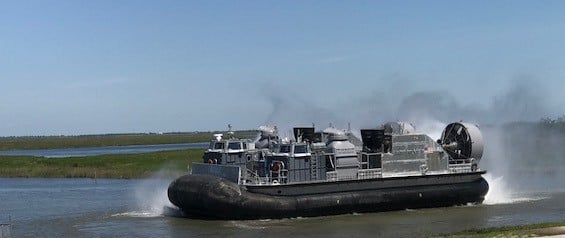
Textron Marine and Land Systems last week began at-sea testing of its first Ship-to-Shore Connector and was also awarded a contract modification to begin procuring long-lead materials for Fiscal Year 2017 and 2018 craft.
The Ship-to-Shore Connector, which looks similar to the Landing Craft Air Cushion (LCAC) it replaces, improves on the legacy craft by adding a fly-by-wire control system, a new drive and propulsion system and more powerful engines, all while reducing the total number of parts to simplify the logistics chain and maintenance requirements.
Scott Allen, Textron’s vice president for marine systems, told USNI News last week that the new design includes mature systems but has required a focused effort on integrated those components ahead of putting the first craft in the water.
“When you build an entirely new type of craft, you have individual components that may have a technical readiness level or manufacturing readiness level that’s an 8 or 9, but when you bring them together for the first time that interface readiness level is sometimes not as mature as you’d like for it to be. So what we spent a lot of time working on with this first-in-class over the last six months has been developing those interfaces, making sure that all the systems are fully integrated and ready to do into the water,” he said during an interview at the Navy League’s Sea Air Space 2018 symposium.
“As an example, we have a lot of new cable runs that go through this craft to support all of our different systems that are operating electronically or hydraulically, and within each of those compartments – and there’s 66 of those compartments – they have to be sealed so they’re watertight. So in preparation for this test there’s a series of just normal type U.S. Navy requirements to ensure that the craft is ready to go in the water. A lot of that, as I said before, had to do with watertightness, had to do with system operation and integration, how well was the system performing and was it performing to the level that both SUPSHIP (the Navy’s Supervisor of Shipbuilding, Conversion and Repair) and Textron Marine felt comfortable putting it in the water.”
The first craft, called LCAC 100, got underway in a bayou near the East New Orleans shipyard on April 10. Allen said Textron pilots had been conducting testing while tethered to a ramp ahead of time to prepare for the first in-water event, and the official builder’s trials would soon follow now that the craft is in the water.
After a week to two weeks of builder’s trials events, Textron will go back and address any deficiencies found in the system and then move into Navy acceptance trials, which will be run by the Navy using LCAC crews from Assault Craft Units 4 and 5. Assuming acceptance trials go well, LCAC 100 will be preliminarily accepted by the Navy and transferred to a test facility in Panama City, Fla., for additional testing.
LCAC 101, the first of six initial operational capability (IOC) craft, is set to come off the production line by the end of this month and then, after its own testing scheduled, deliver this fall to ACU-4.
Allen said testing on LCAC 100 had shown “no show-stoppers” in terms of finding deficiencies or changes that need to be inserted into the production line, but he did note that “all of the learning that we got from 100 is rolled back into 101 – so where you discover things and it takes some time to work through it, we’re able to actually already have that baked in when 101 comes off the line at the end of this month. It will save us a lot of time in testing going forward.”
Allen said the production line is currently set to deliver five craft a year, or one about every 10 weeks. Over the next two years, it will ramp up to build eight a year, or one every six weeks.
The company is currently under contract for crafts 100 through 108, and Allen said the company intends to bring LCAC 109 into production smoothly, with no gaps in manufacturing. He said the Navy has released a request for proposals for the 10 craft in FY 2017 and 2018, and “we’re working up our response to that, and we owe that to the Navy by the end of this month.”
In the meantime, on April 13, the Navy awarded Textron a $7.9 million contract modification to buy long-lead materials for LCACs 109 through 112.





